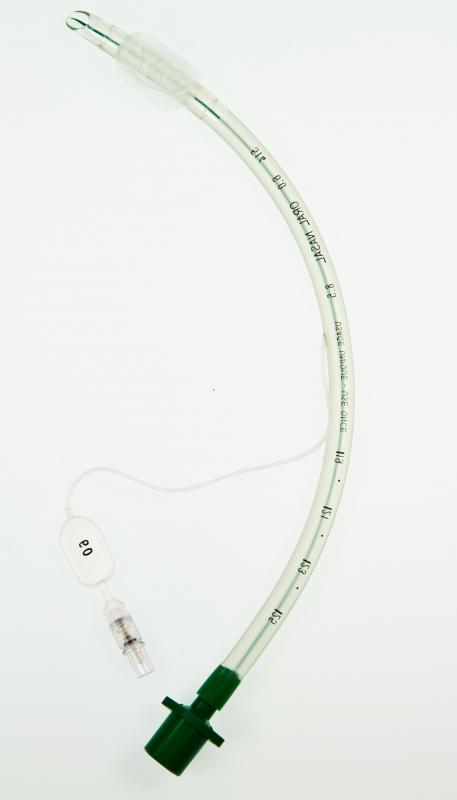At WiseGEEK, we're committed to delivering accurate, trustworthy information. Our expert-authored content is rigorously fact-checked and sourced from credible authorities. Discover how we uphold the highest standards in providing you with reliable knowledge.
What are the Different Types of Anesthesia Procedures?
Depending on the type of surgery to be performed, and the individual needs of the patient, various anesthesia procedures may be utilized. When a specific operation requires a patient to be rendered medically unconscious, general anesthesia is commonly indicated. It is frequently administered for complicated or extended operations or in situations where the patient may suffer from pain or distress if he or she was to remain awake. Other types of surgery may be carried out using localized numbing agents while the patient is alert. Sometimes, however, additional medication is administered to help the person relax or fall asleep during surgery.
Simple procedures where surgical areas are small or superficial often require a basic local anesthetic. In this case, a numbing agent is injected into the area where minor surgery will be performed. Pain sensations are then blocked in the limited region. The patient can often remain fully conscious and aware.

An injection of local anesthetic is also used during regional anesthesia procedures. The difference is that the numbing agent is injected near major nerves, or even the spinal cord. When larger areas of the body require anesthetic to prevent pain, such as the leg, foot or face, the numbing agent is injected around the peripheral nerve group that delivers sensations to that specific part of the body. Many times, additional medicine is administered, usually through an IV, to help the patient relax or sleep during surgery.

Some operations require anesthesia procedures that numb an entire portion of the body, such as the abdomen, pelvis or both legs. For example, an epidural nerve block is commonly used when pregnant women are in labor because it generally provides complete numbing of the lower half of the body. It can also be used during surgery. These anesthesia procedures are quite common during cesarean section operations, a technique used to deliver newborn babies through an incision in the lower abdomen when a vaginal birth is not indicated. This allows the new mother to remain awake, without feeling pain, while her baby is surgically delivered.

General anesthesia is usually considered the most complex of all anesthesia procedures. Using a combination of drugs, such as sedative hypnotics and pain medication, it is designed to render the patient completely unconscious. The medicine is most frequently administered through an intravenous (IV) injection. Sometimes, an inhaled gas through a mask is also used for sedation. This procedure requires constant supervision by an anesthesiologist, a medical professional who specializes in pain management and chemical sedation.
Prior to surgery, the anesthesiologist will usually meet with the patient to obtain a current medical history and examine the individual's throat. This is because endotracheal intubation is often needed to assist the patient with breathing while he or she is sedated because the paralytic effect of general anesthesia makes it difficult for the mind to control the normal involuntary breathing response. Endotracheal intubation consists of a tube inserted into the patient's mouth and through the trachea, allowing a machine to control breathing while the patient is rendered medically unconscious by the drugs.
Once the patient is anesthetized, he or she is usually unable to feel any sensation, including pain, and is mentally unaware of anything that is taking place. From the time the patient is placed under general anesthesia to the time he or she wakes up, it usually feels like seconds have passed when in fact, it may have been several hours. The medication also has an amnesiac quality to it, so it is unlikely that the patient will remember being transported to the operating room, the surgery itself, or even the time spent in recovery immediately following the procedure. Not all surgery requires this type of sedation, however.
AS FEATURED ON:
AS FEATURED ON:













Discussion Comments
I had never been put under general anesthesia until I had to have a tooth extracted by an oral surgeon. The nurse started an IV drip in the back of my hand and put an oxygen mask over my mouth and nose. The pure oxygen made me feel better. When the oral surgeon came in, he started pouring a very cold liquid over my hand and then made a quick injection with the anesthesia. There was no counting back from 100 or anything else I'd seen in movies. I was awake when he injected me and completely unconscious seconds later.
When they say a few hours can feel like a few seconds under anesthesia, they're not kidding. I felt like I had fallen asleep five minutes before I became aware of medical instruments being removed from my chest area. I could hear the nurse's voice, but I couldn't see her at first. I woke up completely and realized my mouth was packed with gauze and the procedure was over. It was not a bad experience once I got past the anxiety of the needles and the fear of extreme pain.
Post your comments